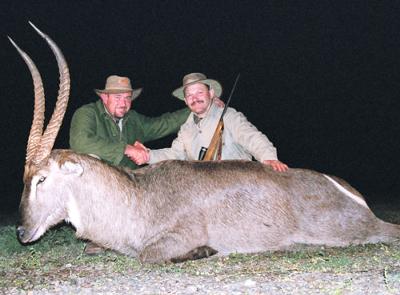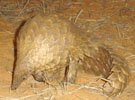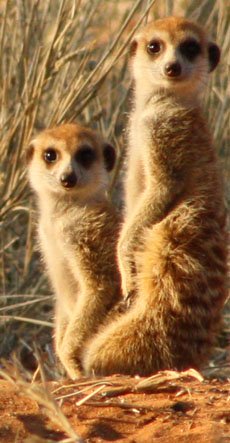For more information about our hunting safaris, don’t hesitate to reach out and contact us!
There's an Impala you want to shoot!
by Roger D. Libby
(Otis Orchards, WA, USA)
It was cool in the early morning dawn, but I was filled with excitement and nervous energy. I couldn’t wait to start hunting. With my rifle safely in the gun rack, we were finally underway.
As we entered the Bushveld, Freddie slowed the Land Rover and all eyes intently gazed into the thickets ahead. It wasn’t long before we were spotting animals. A flash of two young Waterbuck bulls in the marsh to our left. A herd of Sable passing several hundred yards in front of us.
To say that I was absolutely enthralled with these wonderful creatures would be an understatement. At each sighting, Riaan would quickly raise his binoculars, and just as quickly lower them once again, and motion for Freddie to continue on. These were either not the animals we were after, or didn’t measure up to Riaan’s standards.
Throughout the day, we continued to spot several groups of animals, but again, not what we were searching for. In my mind, this is what makes hunting in Africa so unique and appealing. You spot a tremendous number of animals, and you see species that are totally different from what we are accustomed to on the North American continent. There is intrigue and excitement around virtually every corner.
After a relaxing and enjoyable lunch we continued on, and again it wasn't long before we were glassing more animals. Zebra, Blesbok, Red Hartebeest, and Impala just to name a few, seemed to appear at every turn or rise in the road. Suddenly, Daniel motioned to the right. He had seen something! Riaan promptly told me that they had spotted a group of Gemsbok with what appeared to be a couple of good bulls. Dismounting the Land Rover, we were quickly in pursuit.
We hadn’t gone far, when Riaan suddenly motioned for me to stop. To our right was a herd of Eland, bedded in the shade of the Mopane trees. They hadn’t yet spotted us, but if we continued on our course, they would certainly bolt, taking the Gemsbok with them. Riaan briefly surveyed the situation.
We had two choices. We could either retreat, and circle far to our left, and out of sight of the wary Eland, or we could attempt to crawl past them. Fearful that the first plan would take too long, and we would lose the herd of Gemsbok, Riaan decided to go with the second option.
We slowly dropped to our bellies, and bit-by-bit moved quietly past the resting herd. The hard packed sand was hot and abrasive, but I was too focused on the herd of Eland to feel the pain. We crawled for nearly 600 yards, and what seemed an eternity, but finally we were out of sight.
Once we were back on our feet, it took a few minutes to completely straighten up, and allow the kinks to subside from my tense muscles. I could now feel the burn of the abrasions on my elbows and knees.
We were once again in pursuit, but the Gemsbok had put a considerable distance between us. Undaunted, we continued the chase.
Suddenly, off to our right, in the midst of a large clearing was a herd of at least 100 Impala, grazing in the tall grass. What a spectacular sight. I was mesmerized by the spectacle before me. Riaan rapidly scanned the herd with his binoculars, and quickly exclaimed, "There's an Impala you want to shoot!"
His words immediately brought me back to reality. A very large ram, with tall lyre shaped horns, was feeding a few hundred yards away. Within seconds however, he was obstructed by a large mopane tree approximately 75 yards in front of us as he continued moving to our left.
The light was beginning to fade, and we needed to make our move. It was now or never. We crouched as low as possible, and quickly made our way to the mopane tree. As I searched for a limb to use as a rest, and an opening to shoot through, Riaan kept his binoculars fixed on our prize.
I finally had what felt to be a steady rest, but only a very small opening to shoot through the dense foliage. As I found the Impala in my scope I was frustrated to find that he had now fed behind some brush, obscuring his vitals.
The light was quickly fading along with my optimism. Suddenly, he was moving forward again, but as he stepped from behind the brush, two female Impala stepped alongside him and stopped. Once again, no shot opportunity. Each time the two females moved forward, he followed, and between the two of them, they unknowingly kept him protected.
They stopped. He stopped. They moved. He moved. I began to panic, thinking that this Impala of a lifetime would soon escape into the darkness.
All of a sudden, the lead female moved forward slightly. He, and the other female stayed put. This was the chance I had been waiting for. Only his front shoulder was exposed, but enough so that I was sure there was no chance of hitting any of the other animals.
I quickly found his reddish brown shoulder, steadied the crosshairs, and squeezed. I barely heard the roar of my 300 Win. Mag., but vividly saw the orange blast from the muzzle, as the burning powder was bright in the dim light and shade of the tree.
Impala were running everywhere, but where was he? Did I miss? What the hell happened? Out of the blue, a huge slap on the back. "You got him, he’s down. Good shooting."
As Riaan congratulated me, the reality of the moment, and the excitement were nearly overwhelming. We moved forward in the now encroaching twilight, and there he was.
What a magnificent and beautiful creature.
Finally, after years of dreaming, countless hours of planning and waiting, days of traveling, and the exciting but exhausting stalk, I had my first African trophy. And what a trophy he was. I later learned that he would be number 23 in the SCI record book.
What an incredible start to a fabulous 14-day safari. It only seemed appropriate that my first trophy is also perhaps the epitome of South African Plains game. The sleek, graceful, and athletic Impala. It couldn’t have played out any better.
As darkness descended upon us, we talked of the days events as we waited for Freddie and the Land Rover. Once back at the lodge, the first stop was the skinning shed, where we continued to marvel at this magnificent creature. Later that evening, it was fried Impala oysters and wine in celebration of our success.
What a wonderful adventure it had been. As I lay on my bed, exhausted from the long day now behind me, I reflected on all the wonderous sights I had seen, and the friends I had made. It truly doesn’t get any better than this. I can’t wait to see what tomorrow brings!
In the end, I added 3 more gold medal animals, including a huge Waterbuck, a Blesbok, and Black Wildebeest, 2 silver medal animals including a Common Mountain Reedbuck and Springbuck, and last but certainly not least, a beautiful Gemsbok.
This adventure was truly the hunt of a lifetime, a dream come true.
I can’t wait to do it again. Africa is a mystical and magical place. I will be back!
Roger D. Libby
Comments for There's an Impala you want to shoot!
|
||
|
||
|
||
|
||
|
||
|
||
Meaning of "Uitspan"
'Uitspan' is an Afrikaans word that means place of rest.
When the Boer settlers moved inland in Southern Africa in the 1800's, they used ox carts. When they found a spot with game, water and green grass, they arranged their ox carts into a circular laager for protection against wild animals and stopped for a rest.
They referred to such an action of relaxation for man and beast, as Uitspan.
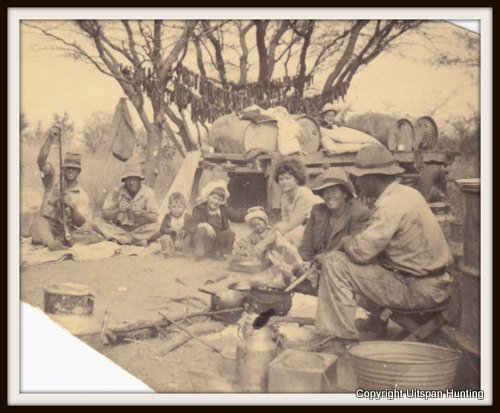
(Picture above of our ancestors.)
Did you know?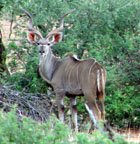 Greater Southern Kudus are famous for their ability to jump high fences. A 2 m (6.56 ft) fence is easily jumped while a 3 m (9.84 ft) high fence is jumped spontaneously. These strong jumpers are known to jump up to 3.5 m (11.48 ft) under stress. |
Did you know? Some animals have one sense more than man!The flehmen response is a particular type of curling of the upper lip in ungulates, felids and many other mammals. This action facilitates the transfer of pheromones and other scents into the vomeronasal organ, also called the Jacobson's Organ. Some animals have one sense more than man!The flehmen response is a particular type of curling of the upper lip in ungulates, felids and many other mammals. This action facilitates the transfer of pheromones and other scents into the vomeronasal organ, also called the Jacobson's Organ.This behavior allows animals to detect scents (for example from urine) of other members of their species or clues to the presence of prey. Flehming allows the animals to determine several factors, including the presence or absence of estrus, the physiological state of the animal, and how long ago the animal passed by. This particular response is recognizable in males when smelling the urine of a females in heat. |
